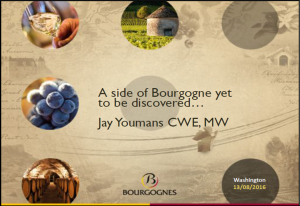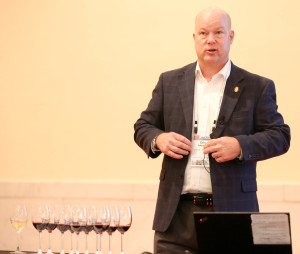The following sessions were enjoyed by all on Saturday afternoon, August 13, 2016 as part of SWE’s 40th Annual Conference, held at the Mayflower Hotel in Washington DC!
A Side of Bourgogne Yet to be Discovered – presented by Jay Youmans, CWE, MW: Did you know that within each subregion of Bourgogne, there are many appellations that remain relatively obscure to the US Market? In this session, attendees were able to examine a good number of these lesser-known AOCs and just what it is about them that merits consideration by the US—both trade and consumer.
Beginning with the far north of Bourgogne, undiscovered regions include Saint-Bris AOC which produces a white wine based on Sauvignon Blanc and Sauvignon Gris, Petit Chablis with its Chardonnay, and Irancy which produces red with based on Pinot Noir with up to 10% César.
Among the Côte d’Or, regions, some standout “undiscovered” regions include the AOC of the Hautes Côtes de Nuits; the attendees were able to sample a white wine from this AOC as well as red wines from Auxey Duresses, Givry Premier Cru, Monthélie, and Fixin.
The area of the Côte Chalonnaise includes the “undiscovered” areas of Bouzeron, known for its Aligoté, as well as the AOCs of Givry, Mercurey, Rully, and Montagny (which provided another delicious white wine for the group to try). The Mâconnais contains the familiar regions of Pouilly-Fuissé and Saint-Véran, but as this class found out, the AOCs of Pouilly-Loché, Pouilly-Vinzelles, and Viré-Clessé produce delicious wines as well! For more information on the undiscovered AOCs of Bourgogne, and details on the wines served at the session, click here to download the slideshow: a-side-of-bourgogne-yet-to-be-discovered-presented-by-jay-youmans-mw
International Bordeaux Blends—Blind Tasting Seminar, presented by Eric Hemer, CWE, MS, MW: This session began with a discussion of the history of the Cabernet Sauvignon grape variety, beginning with its origin in (assumed) early eighteenth century France (in Bordeaux’s Médoc), all the way through the prolific grapes off-spring varieties of Marselan, Centurian, and Ruby Cabernet.
The physical characteristics of the grape (high vigor, late budding, thick-skinned, high tannin) and growing areas were discussed (France, followed by Chile, California, Australia, China, and Argentina). Following this, the grape’s most popular blending partner were examined; the most important being Merlot, followed by Cabernet Franc, Petit Verdot, Malbec, Carmenère, Shiraz, and Sangiovese.
Then, the blind tasting began. Ten Cabernet Sauvignon-based wines from around the world, in vintages ranging from 2009 to 2013 were tasted blind, followed by a discussion of the wine’s major characteristics and flavor attributes. After each discussion, the attendees were invited to decide whether the wines was New World or Old World, give a possible region of origin, and guestimate the percentage of Cabernet Sauvignon in the wine. For more information on the session and the wines included in the tasting, download the slide show here: international-bordeaux-blends-blind-tasting-and-seminar-presented-by-eric-hemer-cwe-ms-mw
Wines of Ningxia China: Old World, New World, or Unique presented by Houghton Lee and Tommy Lam: Located somewhat in central China, Ningxia is a young a fast-growing wine region. International grape varieties were first brought to the area in 1982 and there are now 85 operating wineries and over 87,000 commercial acres of vines. China’s first geographically protected wine region, the Eastern Foot of Helan Mountain, is located in Ningxia.
The leading white grape varieties of Ningxia are Chardonnay, Italian Riesling, Riesling, and Vidal. Red grapes are more widely planted than white varieties and include Cabernet Sauvignon, Merlot, Cabernet Franc, and Pinot Noir (among others).
The tasting portion of the session began with Kanaan Winery Riesling 2013 and Legacy Peak Chardonnay 2014. From there, the tasting focused on red varieties beginning with Sha-Po-Tou Winery’s Cabernet Gernischt 2013, Domaine Pushance Marselan 2014, and Chateau Zhihui Yuanshi “Son of Mountain” Cabernet Sauvignon 2011. For more information on the Ningxia wine region and the wines tasting at the session, click here to download the: wines-of-ningxia-china-presented-by-hougton-lee-and-tommy-lam
We will be posting additional conference recaps in the next few days. In addition, we are building our permanent archive of notes from the 2016 SWE Conference-click here! If you are a conference speaker who would like to share your materials, please contact Jane A. Nickles at jnickles@societyofwineeducators.org


